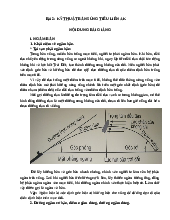










Preview text:
CHAPTER 2: LITERATURE REVIEW
2.1 Concepts and theories:
In order to determine which study models are appropriate for survey subjects
in Vietnam, our team conducted research and made selections from prior studies.
The group's research model is depicted below. In this study, the dependent variable
is CBIL, and the independent variables are CBI, BT, AC, and CS. It was also
developed into a total of 9 hypotheses, and in order to understand this model better,
we had to investigate the definition of each variable and identify any significant
relationships between them.
2.1.1 Customer Brand Identification (CBI)
CBI has been identified by researchers studying hospitality and tourism as a
crucial but underused phenomenon (Martinez & Rodriguez Del Bosque, 2013; So et al.,
2013). As previously indicated, the SIT explains that people typically develop a social
identity in addition to their personal identity (Bhattacharya & Sen, 2003; Tajfel & Turner,
1986). According to Bhattacharya and Sen (2003), client brand identification is either the
degree to which the customer perceives his or her own self-image as overlapping with the
brand's image or the psychological condition of recognizing, feeling, and valuing one's
belongingness to a brand (Lam et al., 2013). Through socially recognized relationships,
consumers develop their sense of identity and express themselves (e.g. Keh & Xie, 2009).
There is currently little understanding of CBI and how it fits into a framework with
other social transaction categories like affective commitment (Martinez & Rodriguez Del
Bosque, 2013; Su et al., 2016). According to studies, CBI is an important factor in
marketing for fostering and sustaining client loyalty to a business (Keh & Xie, 2009).
Customer commitment develops more readily when consumers identify with a brand
(Tuskej et al., 2013). Su et al. (2016) establish through their SIT-informed perspective
that greater shared values between hotel service providers and their customers will
increase the customer's affective commitment to maintaining a relationship with the hotel.
Therefore, we propose that CBI has a significant role in influencing affective commitment.
2.1.2 Customer Brand Identification of Loyalty (CBIL)
Attitude and behavioral metrics can be used to define and rate loyalty. The
behavioral perspective refers to the idea of frequent patronage, but the attitudinal
dimension refers to a specific desire to maintain a relationship with a service provider.
Customer loyalty includes consumers' intentions to return and make more purchases (also
known as behavioral loyalty), opinions of the brand and organization, and desire to
recommend the business to important people.
The crucial component of loyalty known as behavioral intention is "a stated likelihood
to engage in a conduct" (Oliver, 1997, p. 28). A crucial component of behavioral
intention, along with word-of-mouth intention, is customers' intention to make additional
purchases (Chen & Chen, 2010; Oliver, 1997). Customers' intentions to use a specific
service provider again and their willingness to refer that service provider to others are
indicators of the degree of their behavioral intention (Chen & Chen, 2010). The conative
loyalty of a customer is typically represented by favorable behavioral intentions (Chen &
Chen, 2010). According to researchers, relationship marketing has become a crucial
component of marketing strategies, especially for hotels, in order to preserve customer
loyalty (Chen & Chen, 2010; Sui & Baloglu, 2003). Most hotels have loyalty or reward
programs, frequently monitor their clients'
2.1.2 Brand Trust (BT)
According to Morgan & Hunt (1994), researchers in relationship marketing view trust
and commitment as constructs that encourage efficiency, effectiveness, productivity, and
the development of business relationships. 2003 (Sui and Baloglu). According to Morgan
& Hunt (1994), trust is defined as the degree of confidence in an exchange partner's
honesty, credibility, benevolence, and consistency (Morgan & Hunt, 1994). A customer's
belief in the service provider's capacity to provide high-quality services is known as
credibility trust, while the customer's belief in the provider's capacity to provide
competent and dependable service is known as benevolence trust (Kandampully et al.,
2015, p. 393). As a result of numerous interactions with a service provider, perceptions of
trust grow over time (Shukla et al., 2016, p. 325). In the hospitality industry, trust in a
brand has been found to be just as important as customer satisfaction in maintaining long-
term relationships with customers (Martinez & Rodriguez Del Bosque, 2013, 2014).
2.1.3 Affective Commitment (AC)
Affective commitment to a brand or product has been cited as a vital element to
maintain and develop customer loyalty (Curth, Uhrich, & Benkenstein, ; 2014 Geyskens,
Steenkamp, Scheer, & Kumar, ; 1996 Sui & Baloglu, ).
2003 In relation- ship marketing
research, affective commitment is an important concept (Curth et al., ; 2014 Hennig-
Thurau, Gwinner, & Gremler, ; 2002 Rather & Parray, ; 2018 Sui & Baloglu, ). 2003 Allen
and Meyer (1990) divide commitment into three components—affective commitment,
normative commitment, and continuance/cal- culative commitment. Affective
commitment measures the emotional attachment and feelings that customers establish
with a firm providing service while continu- ance/calculative commitment evaluates
customers’ inclination to remain with the firm, due to a lack of better alternatives. On the
other hand, customers who are normatively committed to a firm have a sense of
obligation to remain in the relationship (Shukla, Banerjee, & Singh, , 2016 p. 324).
Affective commitment is a more emotional, or “hotter,” factor that develops through
personal involvement or reciprocity that a customer has with a firm, resulting in a higher
level of trust and commitment (Fullerton, ).
2003 When customers come to like (or, in
some cases, love) a particular firm or brand, they are exhibiting affective attachment or commitment (Fullerton, ).
2003 As such, this study defines emotional or affective
commitment as liking a partner (firm), enjoying the partnership, and having a sense of
belongingness (Geyskens et al., ; 1996 Morgan & Hunt, ). 1994
Two types of knowledge exist: knowledge that is both objective and subjective.
According to Metcalfe (1986) [15], objective knowledge is the degree to which clients
are aware, whereas subject one knowledge is the degree to which clients believe they
understand the subject in terms of memory and problem solving. According to Mishra
and Partners (2017) [16], we define subjective knowledge as "environmental awareness
of green packaging," which is a perception of the benefits of using green packaging as an
alternative for the environment. Subjective awareness has an impact on consumer
attitudes and behavior, according to some researchers (Kim & Han, 2010; 2017, Misha
and her partner; Pathak and Yadav, 2016). Based on research on retailers who use green
grocery packaging, Su and partner (2020) [17] discovered that subjective knowledge of
green packaging has an indirect effect on Vietnamese behavior through attitude.
According to Singh and Pandey (2018)[18], knowledge is also necessary for forming
favorable opinions of eco-friendly packaging. According to Mishra and Partners (2017)
[19], consumers who use green packaging more frequently seem to be more convinced
that doing so would be beneficial. However, the idea of green packaging is not a clear
indicator of behavior in the research conducted by Su and a partner (2020) [20].
According to Aman and Partner (2012) [21], an examination of Malaysian consumers
revealed that knowledge was significant in predicting green purchases but had no effect
on attitudes. Consequently, this report will verify that interest in eco-friendly packaging is still a work in progress.
2.1.4 Customer satisfaction (CS)
According to Oliver (1997), customer satisfaction is defined as the psychological state
that results when the customer's prior feelings regarding the consumption experience and
the emotion surrounding the unmet expectation are combined. After determining whether
their experience with the product or service was pleasant or satisfactory, customers
frequently decide to purchase or repurchase (Ali et al., 2016; (2010) (Chen and Chen)
According to the expectation disconfirmation theory, customers are satisfied when actual
company performance matches or exceeds previous expectations (e.g. Oliver, 1997).
When expectations and outcomes diverge, disconfirmation takes place. Negative
disconfirmation occurs when the performance of a product or service is lower than
anticipated, whereas positive disconfirmation occurs when the performance of a product
or service is higher than anticipated. According to Oliver (1997), positive or negative
confirmation results in customer satisfaction, while confirmation results in customer dissatisfaction.
Customers' future loyalty to the service provider may be influenced by how satisfied they
are with the service. According to Hennig-Thurau et al., satisfied customers may increase
their commitment to the service. 2002). According to Morgan & Hunt (1994), prior
research, a customer's evaluation of satisfaction with his or her consumption experience
has a positive impact on their states of commitment. Relationships that last a lifetime
have been linked to high levels of satisfaction (Sui & Baloglu, 2003). However, the
affective commitment dimension was taken into account for the purpose of this study
because it has been recognized in marketing literature as being effective in establishing
consumer behavior (Curth et al., 2014, p. 148). Additionally, a customer's willingness to
return to a business (like a hotel) and to recommend it to others is strongly correlated
with their level of contentment (Su et al., 2016, Rather, Sharma, and According to Liat et
al., in the hospitality industry, customers who are pleased with the services provided by a
hotel are more likely to be emotionally attached to those services, resulting in customer
loyalty to the hotel. 2017; 2016 Tanford).
2.2 Previous studies 2.2.1
The research “Customer brand identification, affective commitment, customer
satisfaction, and brand trust as antecedents of customer behavioral intention of
loyalty: An empirical study in the hospitality sector” by Raouf Ahmad Rather,
Shehnaz Tehseen, Murtaza Hassan Itoo & Shakir Hussain Parrey, 2019. This study
aimed to investigate the effects of customer brand identification (CBI), emotional
commitment, customer satisfaction, and brand trust on the development of
customer behavioral intention of loyalty (CBIL) in the hotel industry. This study's
underlying ideas include social identity theory and relationship marketing theory.
The social identity theory (SIT) was used as the investigation model
The social identity theory (SIT) is the basic theoretical underpinning of
identification in both marketing literature and organizational studies (Lam,
Ahearne, Mullins, Hayati, &Schillewaert, 2013; Tajfel & Turner, 1986). According
to the SIT, persons often establish a social identity in addition to their personal
identity (Bhattacharya & Sen, 2003;Tajfel & Turner, 1986). CBI discusses why
people may relate to businesses based on the SIT (Tajfel & Turner, 1986).
Bhattacharya and Sen (2003) expanded the notion of customer identification to
customer-brand connections by drawing on SIT and organizational identification.
Identity fit and identity matching are involved in customer identification, which is
fundamentally a perceptual construct (Bhattacharya & Sen, 2003). According to
SIT and self-categorization theory, customer identification occurs when a person
perceives himself/herself as psychologically interwoven with the qualities of a group (So et al., 2013).
In a period of global competitiveness and market volatility, the importance of
relationship marketing cannot be overstated. Firms acknowledge the necessity of
developing and sustaining connections with their consumers in order to remain
competitive. Relationship marketing methods have been widely researched within
the services marketing space since service organizations may create connections
with their clients (Brodie, 2017, p. 20).
To guarantee that clients receive outstanding service, marketing strategies must
also be focused on staff. According to Grönroos (1994, p. 9), relationship
marketing strategies are divided into two parts: enticing clients to the company and
then creating connections with these customers to achieve the intended economic
goals. However, existing connections can only be maintained and improved if
customers' promises are followed.
In the relationship marketing domain, relationship quality is considered an
important concept that indicates the closeness or intensity of the relationship
between a firm and its customers (Vesel & Zabkar, 2010, p. 1336). Although
several factors attribute to relationship quality, satisfaction, trust, and affective
commitment are regarded as central components or predictors of relationship
quality (Van Tonder & Petzer, 2018; Vesel & Zabkar, 2010). Hence, for the purpose
of this study, satisfaction, brand trust, and affective commitment are further
explored to determine their effect on CBIL. 2.2.2
Support Paper : The research conducted by Waris Ali, Yu Danni, Badar Latif ,
Rehana Kouser and Saleh Baqader (2021)
The study examined the role of perceived CSR in deriving customer loyalty by
exploring direct and mediated effects of corporate reputation and customer
satisfaction in Pakistan’s food chains. The data were collected through a survey
method from 322 customers of McDonald’s in Pakistan during October 2019 and
January 2020. The collected information was then analyzed through the Partial
Least Square Structural Equation Modeling (PLS-SEM) technique to test the
hypothesized relationships. The results revealed a significant positive impact of
perceived CSR on customer loyalty, corporate reputation, and customer
satisfaction. Further, customer satisfaction and corporate reputation appeared to
mediate the relationship between perceived CSR and customer loyalty.
Figure 1. Theoretical framework
The theoretorical model of this research demonstrates the mediating role of
corporate reputation and customer satisfaction in the perceived CSR–customer loyalty relationship. 2.2.3
Support paper: The research conducted by James Agyei, Shaorong Sun,
Emmanuel Kofi Penney, Eugene Abrokwah, and Richmond Ofori-Boafo (2021).
The study looks into how customer engagement is affected by corporate social
responsibility (CSR) and how customer-brand identification and customer
satisfaction act as mediators. Structural equation modeling was used to analyze
survey data from 293 life insurance customers. Customer engagement is primarily
driven by CSR, customer brand identification, and customer satisfaction, according
to the findings. In addition, the findings demonstrate that customer-brand
identification and customer satisfaction are significantly influenced by CSR. In
addition, the findings demonstrate that customer-brand identification and
satisfaction play a significant role as mediators in the connection that exists
between CSR and customer engagement. The findings emphasize the significance
of considering corporate social responsibility (CSR) as a strategic tool for eliciting positive customer responses. Figure 2. Research framework
2.3 Research Model and Hypothesis
2.3.1 Research Model.
After a process of research, discussion, and careful consideration, our group has
decided to choose this research model. The first reason is that compared to the
support paper, the research model of the key paper is more detailed. The second
reason is that because this research model is developed and researched later, it also
includes most of the analytical factors from the research papers in previous years.
The final reason leading to the decision to choose this model is because the content
in the previous research articles was quite less information, namely the first
support paper focused on only three theories to develop the model of factors
affecting students' academic performance in higher education while the content in
the next support paper only gives positive/negative effects from social media
applications to student learning behavior. Therefore, the selected research model
generally meets the research needs, desires, and purposes of our group and we
would like to build the research based on this model. 2.3.2 Hypothesis
Affective commitment, CBI, and other social exchange constructs like it provide
little insight into how they fit into a framework (Martinez & Rodriguez Del
Bosque, 2013; Su and co., 2016). According to Keh & Xie (2009), researchers in
the field of marketing have found that CBI is an essential variable in the process of
fostering customer loyalty to a business. The identification of a customer's brand
fosters customer commitment (Tuskej et al., 2013). Su et al. (through its SIT-
informed lens) 2016) also show that customers' affective commitment to
maintaining a relationship with the hotel will increase if hotel service providers
and customers share more values. As a result, we hypothesize that CBI is a
significant factor in affective commitment.
H1: The noteworthy relationship between Customer Brand Identification and Affective Commitment
There are very few empirical studies that incorporate both CBI and customer
satisfaction, despite their recognition as essential components of customer–
provider relationships (Martinez & Rodriguez Del Bosque, 2013; Instead, 2017,
Customers with higher identification levels are more likely to be satisfied with the
company, according to a few authors in JOURNAL OF GLOBAL SCHOLARS OF
MARKETING SCIENCE 201 (Bhattacharya & Sen, 2003; He & Li, 2010).
According to Martinez & Rodriguez Del Bosque (2013), customers in hospitality
settings who have a stronger psychological attachment to a particular hotel brand
are more likely to be satisfied with the establishment. As a result, we speculate that
CBI is a necessary prerequisite for customer satisfaction.
H2: The strongly connection between Customer Brand Identification and Custimer Satisfaction
Although similar support could be derived from the relationship between image
congruence and brand trust (So et al., ), prior research in the field of hospitality and
tourism did not examine the direct influence of CBI on brand trust. 2013).
According to Keh & Xie (2009), customers expect to enhance their self-definition
and self-esteem by identifying with trustworthy brands or organizations, so the
current study suggests that brand trust is one of the essential precursors of an
identified relationship. According to So et al.'s research, upscale hotel guests are
more likely to trust the establishment if they perceive a high degree of congruence
between the hotel's image and their own (desired) identity. 2013). Based on this
perspective, we hypothesize that CBI is a key factor in brand trust.
H3: the massive relation between Customer Brand Identification and Brand Trust
There hasn't been much research done to date on customer brand identification and
loyalty intention (Martinez & Rodriguez Del Bosque, 2013; So and co., 2013).
Individuals' cognitions, perceptions, and assessments of events and issues are
influenced by their social identity, according to the SIT-informed lens; Strong
customer identification with a service brand or product may result in improved
outcomes like increased customer loyalty (He et al., 2012; Huang and others,
2017). As a result, especially for upscale hotels, customers who identify with a
hotel brand are more likely to purchase that brand as a means of self-expression.
As a result, we hypothesize that customer behavior loyalty is influenced in large part by CBI.
H4: The exstremely nexus between Customer Brand Identification and Customer
Behavioural Intention of Loyality
According to Oliver (1997), customer satisfaction is defined as the psychological
state that results when the customer's prior feelings regarding the consumption
experience are combined with the emotion of disconfirmed expectation. After
determining whether their experience with the product or service was pleasant or
satisfactory, customers frequently decide to purchase or repurchase (Ali et al.,
2016; (2010) (Chen and Chen) According to the expectation disconfirmation
theory, customers are satisfied when actual company performance matches or
exceeds previous expectations (e.g. Oliver, 1997). Negative disconfirmation occurs
when the performance of a product or service is lower than anticipated, whereas
positive disconfirmation occurs when the performance of a product or service is higher than anticipated.
Customers' future loyalty to the service provider may be influenced by how
satisfied they are with the service. According to Hennig-Thurau et al., satisfied
customers may increase their commitment to the service. 2002). Relationships that
last a lifetime have been linked to high levels of satisfaction (Sui & Baloglu,
2003). However, the affective commitment dimension was taken into account for
the purpose of this study because it has been recognized in marketing literature as
being effective in establishing consumer behavior (Curth et al., 2014, p. 148).
Additionally, a customer's willingness to return to a business (like a hotel) and to
recommend it to others is strongly correlated with their level of contentment (Su et
al., 2016, Rather, Sharma, and According to Liat et al., in the hospitality industry,
customers who are pleased with the services provided by a hotel are more likely to
be emotionally attached to those services, resulting in customer loyalty to the hotel.
2017; 2016 Tanford). As a result, we propose the following hypotheses:
H5: The considerable between Customer Satisfaction and Affective Commitment
H6: A positive impact between Customer and Customer Behavioural Intention of Loyality




